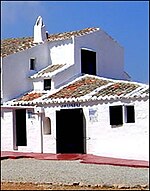| This article needs additional citations for verification. Please help improve this article by adding citations to reliable sources. Unsourced material may be challenged and removed. Find sources: "Cap de Cavalleria Ecomuseum" – news · newspapers · books · scholar · JSTOR (February 2024) (Learn how and when to remove this message) |

The Cap de Cavalleria Ecomuseum is an institution which is located on the northernmost coast of Menorca (Balearic Islands, Spain), in the proximity of Cavalleria Cape and the port of Sanitja (Santa Teresa, Es Mercadal).
History

The Ecomuseum was created in 1997 by the non-profit association “San Nitja. Gestión del Patrimonio Mediterráneo”, with the main objective of protecting, investigating and spreading the cultural and natural resources of Cavalleria and the port of Sanitja. This task is carried out by the interdisciplinary study of the following elements: geological (sedimentation and stratigraphy), biological (native fauna and flora), environmental (preservation of the environment to face up to the pressure of different factors such as tourism), ethnologic (lime kiln, dry walls, lighthouse, etc.), as well as historic and archaeological (Roman military fort, city and medieval mosque), all of them located in the area. Among them, it is worth highlighting the last element mentioned, due to the archaeological interventions in the port of Sanitja, which are carried out in the Roman military fort, dating from the 1st century B. C., and the Roman city of Sanisera (1st century B. C. to 6th century A. D.)
Visitors
The Ecomuseum’s visitors receive all the information related to this territory inside the Santa Teresa building, by means of audiovisual material, scale models and the exhibition of the archaeological findings revealed in the excavations that are carried out in the port of Sanitja. The exhibition “Discover the North!”, inaugurated in 2005, offers a general view of all the elements mentioned above, and it is translated into six languages: Catalan, Spanish, English, German, Italian and French.
Moreover, once visitors has seen the exhibition in the Santa Teresa building, they can continue with the free visit of the surrounding area by following the “7 routes” guide, which starts at the way out of the museum and which complements what is exhibited in the showroom, in order to know the most important cultural and natural elements of the landscape.
References
- Davis, Peter (31 March 2011). Ecomuseums: A Sense of Place. A&C Black. ISBN 978-1-4411-5744-7.
External links
- Ecomuseo de Cap de Cavalleria:Official website of the Cap de Cavalleria Ecomuseum and the archaeological fieldschool at the Roman city of Sanisera.
40°03′55″N 4°5′20″E / 40.06528°N 4.08889°E / 40.06528; 4.08889
Categories: